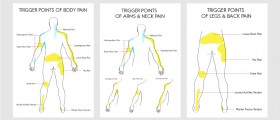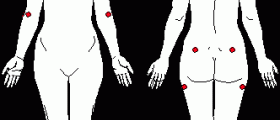
Myofascial pain syndrome is the name for the condition characterized by the severe muscle pain. In this condition, the pain occurs in the most sensitive areas in the muscles and these sensitive points are called trigger points. When a person touches this trigger point, it hurts and the pain usually expands throughout the whole muscle.
Muscle pain, in general, is not a serious health concern and almost everyone experiences it occasionally. However, in those people who suffer from myofascial pain syndrome, the pain tends to persist and aggravate over time. The pain caused by this condition can be associated with pains that occur in many parts of the human body, such as headaches, neck pain, pelvic pain and many other types of pain. The treatment of this syndrome is necessary in order to relieve the symptoms and it includes medications, physical therapy and injections that need to be given in the trigger points.
Symptoms of myofascial pain syndrome
The most common symptom of myofascial pain syndrome is deep pain that occurs in the muscles, that is constant and that becomes worse over time. Those people who suffer from this disorder may experience muscle stiffness or stiffness of joints that are near the affected muscle. Furthermore, a knot or tight spot in the muscle that can be felt under touch and that is also painful to touch is a warning sign of myofascial pain syndrome. Because of the pain, those people with this muscle disorder have problems with sleeping. It is important to consult a doctor if the pain in the muscles prolongs and cannot be eliminated by rest or massages.
The main cause for the occurrence of myofascial pain syndrome lies in the trigger points, which are sensitive areas of tight muscle fibers. They usually form in the muscles after an injury or overuse of the muscles.
Risk factors for myofascial pain syndrome
There are people who are more susceptible to development of the myofascial pain syndrome. For example, even though it is not known why, women are at higher risk to develop this disorder than men. Furthermore, this condition usually affects adults more than the younger population. Myofascial pain syndrome may develop in those people who are physically inactive for some period of time because of a surgery, for example, and then start to use the muscle when they recover. Muscle injuries, as well as stress and anxiety, are also some of the factors that can lead to the occurrence of myofascial pain syndrome.



-vs-Trigger-Points-(Myofascial-Pain-Syndrome)_f_280x120.jpg)













Your thoughts on this
Loading...